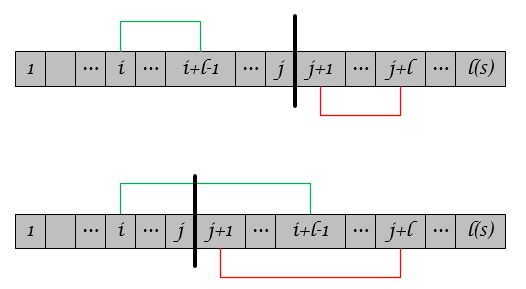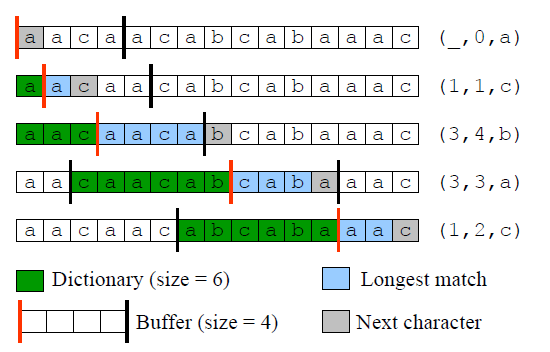1. 引言
LZ77算法是采用字典做数据压缩的算法,由以色列的两位大神Jacob Ziv与Abraham Lempel在1977年发表的论文《A Universal Algorithm for Sequential Data Compression》中提出。
基于统计的数据压缩编码,比如Huffman编码,需要得到先验知识——信源的字符频率,然后进行压缩。但是在大多数情况下,这种先验知识是很难预先获得。因此,设计一种更为通用的数据压缩编码显得尤为重要。LZ77数据压缩算法应运而生,其核心思想:利用数据的重复结构信息来进行数据压缩。举个简单的例子,比如
取之以仁义,守之以仁义者,周也。取之以诈力,守之以诈力者,秦也。
取之以、仁义、,、者、守之以、也、诈力、。均重复出现过,只需指出其之前出现的位置,便可表示这些词。为了指明出现位置,我们定义一个相对位置,如图

相对位置之后的消息串为取之以诈力,守之以诈力者,秦也。,若能匹配相对位置之前的消息串,则编码为以其匹配的消息串的起始与末端index;若未能匹配上,则以原字符编码。相对位置之后的消息串可编码为:[(1-3),(诈力),(6),(7-9),(诈力),(12),(6),(秦),(15-16)],如图所示:

上面的例子展示如何利用索引值来表示词,以达到数据压缩的目的。LZ77算法的核心思想亦是如此,其具体的压缩过程不过比上述例子稍显复杂而已。
2. 原理
本文讲主要讨论LZ77算法如何做压缩及解压缩,关于LZ77算法的唯一可译、无损压缩(即解压可以不丢失地还原信息)的性质,其数学证明参看原论文[1]。
滑动窗口
至于如何描述重复结构信息,LZ77算法给出了更为确切的数学解释。首先,定义字符串(S)的长度为(N),字符串(S)的子串(S_{i,j}, 1le i,j le N)。对于前缀子串(S_{1,j}),记(L_i^j)为首字符(S_{i})的子串与首字符(S_{j+1})的子串最大匹配的长度,即:
我们称字符串(S_{j+1,j+l})匹配了字符串(S_{i,i+l-1}),且匹配长度为(l)。如图所示,存在两类情况:

定义(p^j)为所有情况下的最长匹配的(i)值,即
比如,字符串(S=00101011)且(j=3),则有
- (L_1^j=1),因为(S_{j+1,j+1}=S_{1,1}), (S_{j+1,j+2} e S_{1,2});
- (L_2^j=4),因为(S_{j+1,j+1}=S_{2,2}), (S_{j+1,j+2} = S_{2,3}),(S_{j+1,j+3} = S_{2,4}),(S_{j+1,j+4} = S_{2,5}),(S_{j+1,j+5} e S_{2,6});
- (L_3^j = 0),因为(S_{j+1,j+1} e S_{3,3})。
因此,(p^j = 2)且最长匹配的长度(l^j=4). 从上面的例子中可以看出:子串(S_{j+1,j+p})是可以由(S_{1,j})生成,因而称之为(S_{1,j})的再生扩展(reproducible extension)。LZ77算法的核心思想便源于此——用历史出现过的字符串做词典,编码未来出现的字符,以达到数据压缩的目的。在具体实现中,用滑动窗口(Sliding Window)字典存储历史字符,Lookahead Buffer存储待压缩的字符,Cursor作为两者之间的分隔,如图所示:

并且字典与Lookahead Buffer的长度是固定的。
压缩
用((p,l,c))表示Lookahead Buffer中字符串的最长匹配结果,其中
- (p)表示最长匹配时,字典中字符开始时的位置(相对于Cursor位置),
- (l)为最长匹配字符串的长度,
- (c)指Lookahead Buffer最长匹配结束时的下一字符
压缩的过程,就是重复输出((p,l,c)),并将Cursor移动至(l+1),伪代码如下:
Repeat:
Output (p,l,c),
Cursor --> l+1
Until to the end of string
压缩示例如图所示:

解压缩
为了能保证正确解码,解压缩时的滑动窗口长度与压缩时一样。在解压缩,遇到((p,l,c))大致分为三类情况:
- (p==0)且(l==0),即初始情况,直接解码(c);
- (p>=l),解码为字典
dict[p:p+l+1]; - (p<l),即出现循环编码,需要从左至右循环拼接,伪代码如下:
for(i = p, k = 0; k < length; i++, k++)
out[cursor+k] = dict[i%cursor]
比如,dict=abcd,编码为(2,9,e),则解压缩为output=abcdcdcdcdcdce。
3. 实现
bitarray的实现请参看A Python LZ77-Compressor,下面给出简单的python实现。
# coding=utf-8
class LZ77:
"""
A simplified implementation of LZ77 algorithm
"""
def __init__(self, window_size):
self.window_size = window_size
self.buffer_size = 4
def longest_match(self, data, cursor):
"""
find the longest match between in dictionary and lookahead-buffer
"""
end_buffer = min(cursor + self.buffer_size, len(data))
p = -1
l = -1
c = ''
for j in range(cursor+1, end_buffer+1):
start_index = max(0, cursor - self.window_size + 1)
substring = data[cursor + 1:j + 1]
for i in range(start_index, cursor+1):
repetition = len(substring) / (cursor - i + 1)
last = len(substring) % (cursor - i + 1)
matchedstring = data[i:cursor + 1] * repetition + data[i:i + last]
if matchedstring == substring and len(substring) > l:
p = cursor - i + 1
l = len(substring)
c = data[j+1]
# unmatched string between the two
if p == -1 and l == -1:
return 0, 0, data[cursor + 1]
return p, l, c
def compress(self, message):
"""
compress message
:return: tuples (p, l, c)
"""
i = -1
out = []
# the cursor move until it reaches the end of message
while i < len(message)-1:
(p, l, c) = self.longest_match(message, i)
out.append((p, l, c))
i += (l+1)
return out
def decompress(self, compressed):
"""
decompress the compressed message
:param compressed: tuples (p, l, c)
:return: decompressed message
"""
cursor = -1
out = ''
for (p, l, c) in compressed:
# the initialization
if p == 0 and l == 0:
out += c
elif p >= l:
out += (out[cursor-p+1:cursor+1] + c)
# the repetition of dictionary
elif p < l:
repetition = l / p
last = l % p
out += (out[cursor-p+1:cursor+1] * repetition + out[cursor-p+1:last] + c)
cursor += (l + 1)
return out
if __name__ == '__main__':
compressor = LZ77(6)
origin = list('aacaacabcabaaac')
pack = compressor.compress(origin)
unpack = compressor.decompress(pack)
print pack
print unpack
print unpack == 'aacaacabcabaaac'
4. 参考资料
[1] Ziv, Jacob, and Abraham Lempel. "A universal algorithm for sequential data compression." IEEE Transactions on information theory 23.3 (1977): 337-343.
[2] guyb, 15-853:Algorithms in the Real World.